Abstract
Industrial production (in USD terms) reached USD 1.89 trillion in April 2024, the highest in the world, indicating signs of recovery and growth in the global economy. Over the past few years, and especially the recovery from the pandemic-hit 2020, changes in national policies and consumer demand have been key factors. Industrial production is a key indicator of the health of the economy and reflects the performance of a variety of sectors including manufacturing, energy and construction. The influence of Asian countries, especially China, has been particularly notable and is contributing to the recovery of industrial production. Digital transformation and the shift to green energy are also driving sustainable growth. However, risks such as supply chain disruptions and inflationary pressures remain. These can affect production costs and commodity prices, potentially causing economic instability. Therefore, it will be important for future economic strategies to closely monitor trends in industrial production and assess each country’s policy responses and market changes.
Industrial production (USD basis)
Considering data on industrial production (in USD terms) from 1991 to April 2024, the fluctuations in the global economy are clearly evident. Notably, the peak of $2.09 trillion recorded in March 2023 symbolized a rapid recovery following the pandemic. However, current levels remain at just 90.6% of that peak, meaning challenges remain for the economy to recover. A characteristic of this period is the change in the global economic structure. Industrial production in particular has boomed in emerging countries, especially China, which has become the manufacturing centre of the world. Furthermore, technological innovation and advances in automation have improved productivity and brought about changes in the industrial structure. On the other hand, disruptions to supply chains, geopolitical risks, and fluctuations in energy prices are affecting the economy and threatening the stability of industrial production. Going forward, policies aimed at sustainable growth and adapting to digitalization will be required. It is also important to increase the resilience of the economy as a whole while addressing regional economic disparities and environmental issues. In light of these factors, it is necessary to closely monitor trends in industrial production and take a strategic approach.
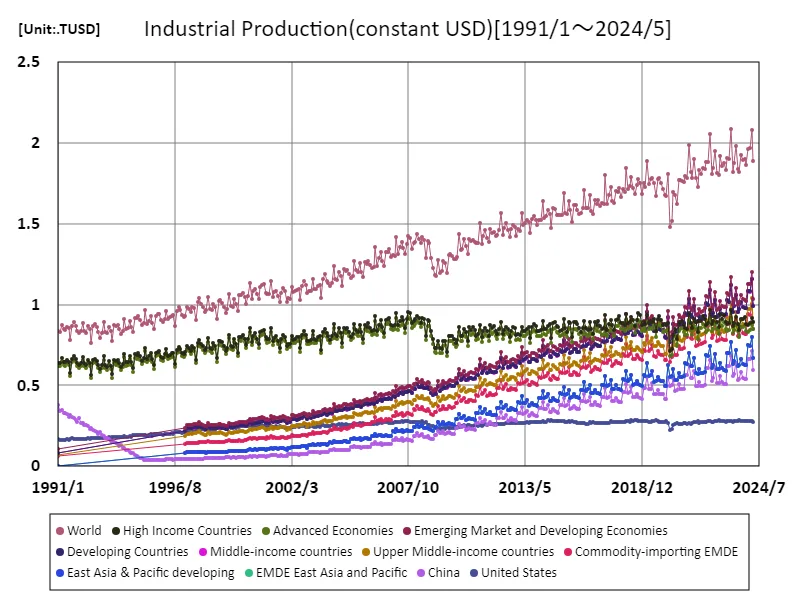

The maximum is 2.09TUSD[2023年3月] of World, and the current value is about 90.6%
Industrial production (USD basis) (worldwide)
Looking at data on industrial production (in USD terms) from January 1991 to April 2024, Australia’s economic situation is unique compared to other countries. The peak was recorded in November 1993 at USD 1.03 trillion, and the current level is just 1.87% of that peak. This downturn reflects the impact of changes in Australia’s industrial structure and economic policies. In particular, Australia is known as a resource-rich country and tends to be highly dependent on mining and agriculture. Therefore, it is characterized by being easily affected by global demand fluctuations and prices. Over the past few decades, the economic growth of Asian countries and the rise of the Chinese market have had a major impact on Australian exports, while fluctuations in resource prices have had a direct impact on industrial production. Additionally, the slowdown in industrial production growth can be attributed to the relocation of manufacturing overseas and the advancement of digitalization. The contraction of manufacturing and the growth of the service sector also contributed to the decline in overall industrial production. Going forward, the introduction of new technologies and industrial diversification will be key to achieving sustainable growth.
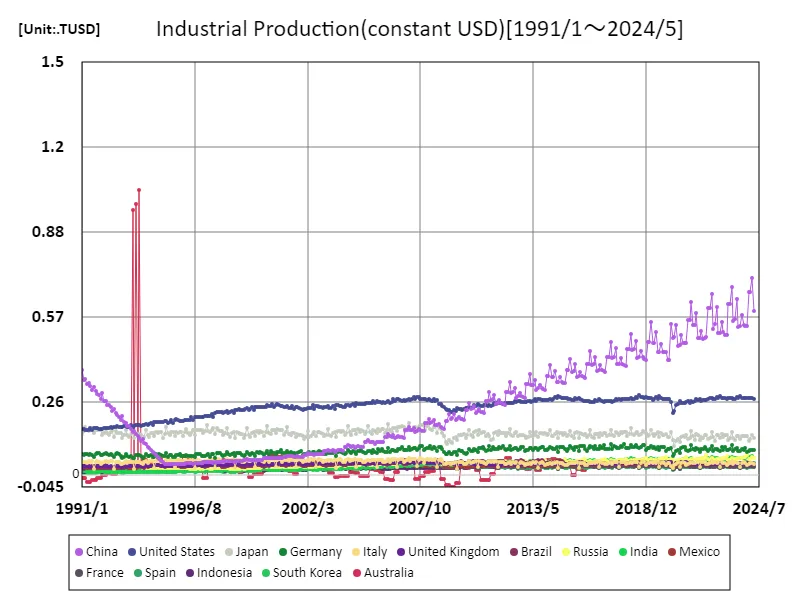

The maximum is 1.03TUSD[1993年11月] of Australia, and the current value is about 1.87%
Industrial production (in USD) (by income, latest year)
Data on industrial production (in USD terms) for May 2023 is a key indicator of global economic trends. Middle-income countries had the highest industrial production at USD 1.16 trillion, with an average of USD 926 billion and a total of USD 3.23 trillion, highlighting their role as centres of economic growth. Middle-income countries have grown their industrial production through the expansion of manufacturing sectors and technological innovation. Asian countries in particular have become an important part of the global supply chain, taking advantage of their cheap labor and access to markets. This has led to increased exports and boosted the domestic economy. But growth also comes with challenges. Supply chain disruptions, inflationary pressures and geopolitical risks are factors that threaten stable production. There is also a need to address environmental issues, making sustainable development a new challenge. Overall, industrial production data reflect growth in middle-income countries, while also suggesting that future economic policies and international cooperation are crucial. Technological innovation and infrastructure investment are essential for these countries to achieve sustainable growth.
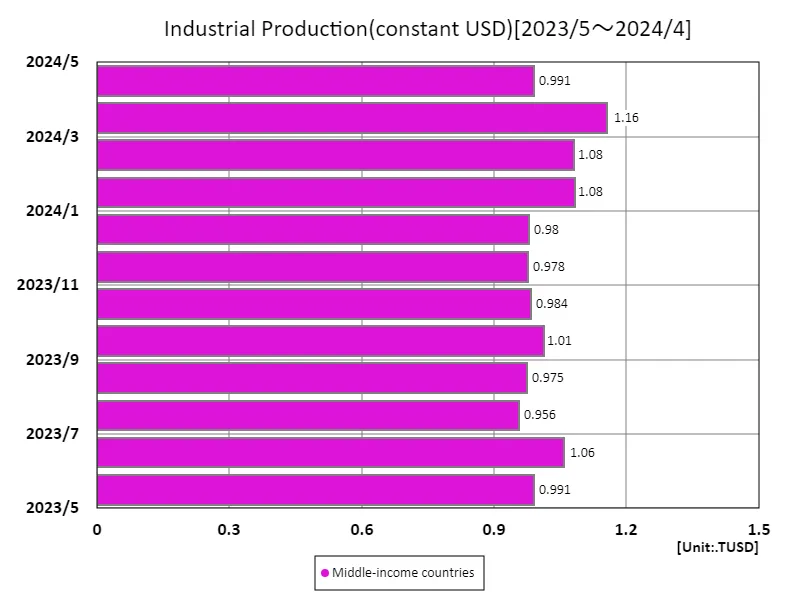

The maximum is 1.16TUSD[2024年3月] of Middle-income countries, and the current value is about 85.7%
Industrial production (USD basis) (region, latest year)
Data on industrial production (USD basis) for April 2024 will be key to understanding trends in the global economy. Middle-income countries had the highest industrial production at USD 991 billion, with an average of USD 926 billion and a total of USD 2.78 trillion, indicating that these countries are acting as centers of economic growth. Middle-income countries are expanding their economies through the development of their manufacturing industries, with Asia in particular leading the way in this growth. Access to low-cost labor and technology is supporting increased industrial production and a growing role in global supply chains. However, challenges such as supply chain disruptions, inflation, and geopolitical tensions require cautious policy responses to maintain sustainable growth. Additionally, with growing environmental concerns, the transition to sustainable technologies and clean energy has also become an important issue. Against this backdrop, industrial production data not only reflects growth in middle-income countries, but also highlights the need for future economic policies and international cooperation. Technological innovation and infrastructure investment are essential to achieving sustainable growth.
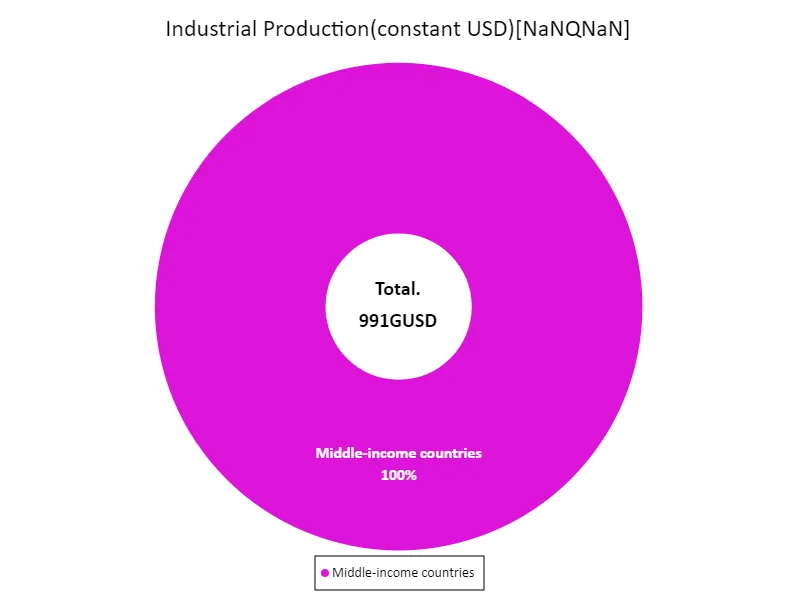

The maximum is 991GUSD of Middle-income countries, the average is 991GUSD, and the total is 991GUSD
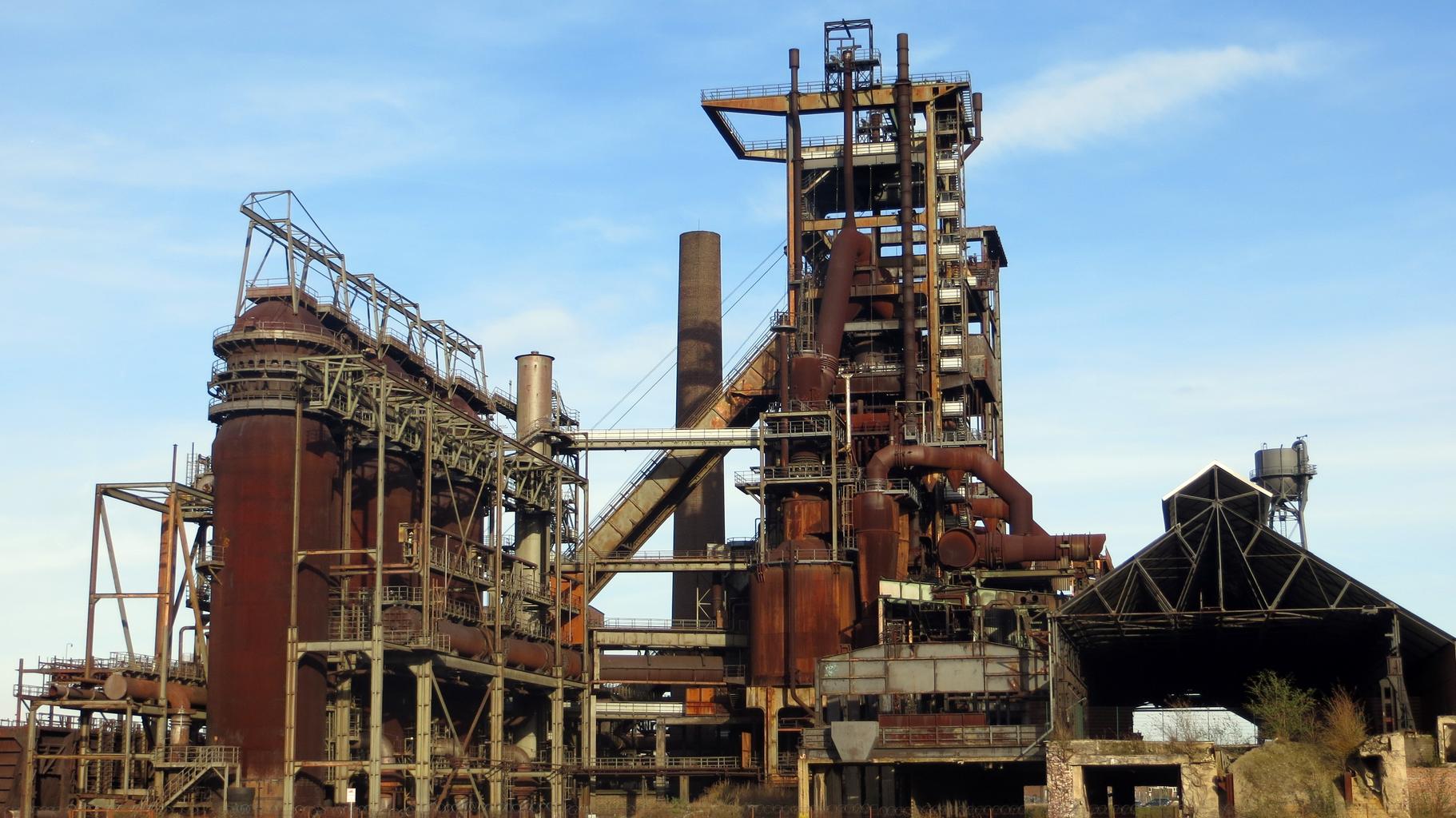


Comments